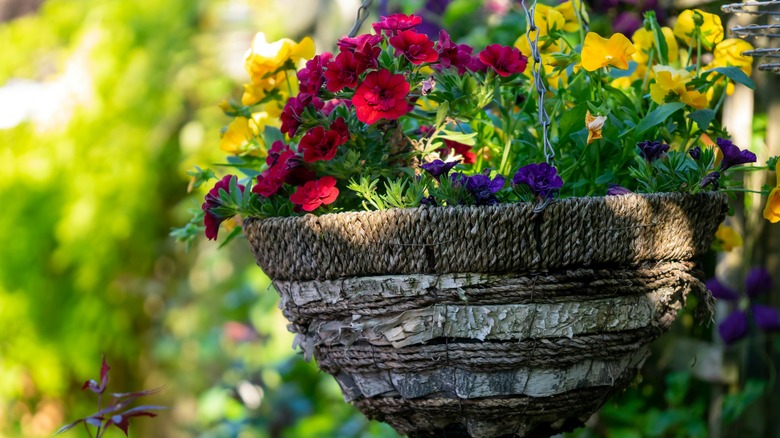The Must-Know Tip To Keep Your Hanging Baskets Looking Full And Beautiful All Season
If your hanging baskets aren't looking as robust as you'd like, they may be telling you they are hungry for nutrients. Because the plants in hanging baskets are in close proximity in a closed container where the volume of soil is quite limited, fertilization is extremely important, especially as rain and frequent watering wash their food away. Keeping your basket plants happy and well fed with fertilizer helps them look sensational with continuous blooms throughout the entire growing season.
It's a challenge for gardeners to maintain lush and attractive baskets for a full season. You can start your basket plants off well with fertilizer at the beginning of the season. If you haven't done that, you can still use fertilizer to perk up your baskets. Whether you've bought your baskets or they're DIY, an essential tip to ensure your flowers thrive in a hanging basket is to rejuvenate them with fertilizer.
Develop a fertilizing plan
Consider fertilizing the soil before even placing plants in your hanging basket. Slow-release granular fertilizer and water-soluble fertilizers are popular, with many gardeners using both. You can use a slow-release product early in the season and then apply water-soluble fertilizer regularly throughout the season, typically every two to three weeks. The recommended ratio of nitrogen, phosphorus, and potassium is 1:2:1. Even when you choose the perfect flower fertilizer, be sure to follow the fertilizer label instructions. Avoid high-nitrogen fertilizers, as they tend to boost foliage growth instead of flower blooms.
Watering and fertilizing go hand in hand with hanging baskets, especially given how watering leaches nutrients from the soil. You'll want to follow watering tricks to maintain a lush hanging basket all summer and apply your fertilizer when the soil is moist. One trick for addressing the leaching issue is to fertilize with smaller amounts but more frequently. Continue to monitor your baskets for signs of nutrient deficiency, such as yellowing leaves, lack of growth, few flower blooms, and pale or wilted foliage. Monitoring is key since environmental factors affect the baskets' fertilizer needs. For example, avoid fertilizing in a heat wave since plants are already stressed and can't handle the growth boost fertilizer provides.

